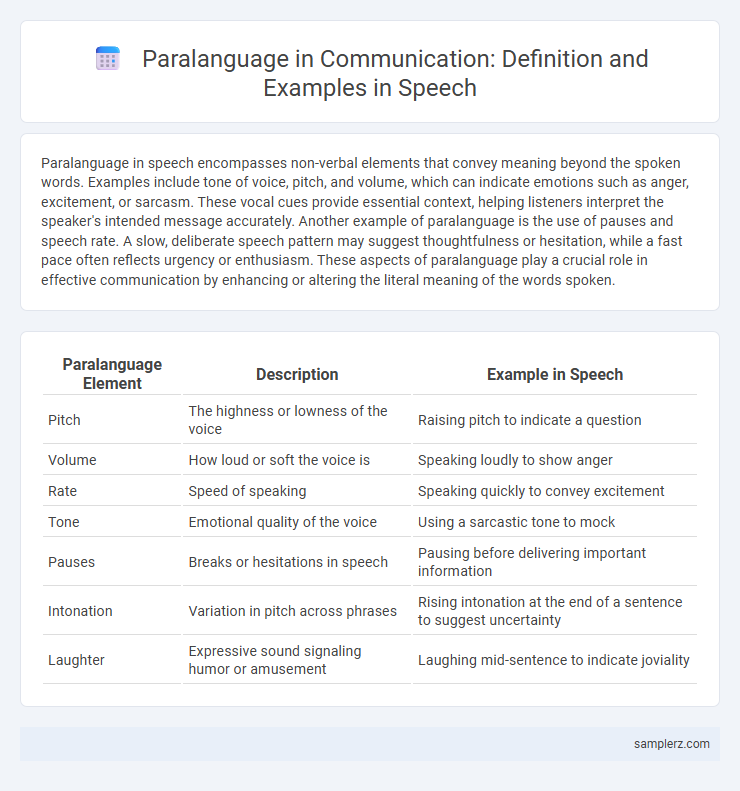Paralanguage in speech encompasses non-verbal elements that convey meaning beyond the spoken words. Examples include tone of voice, pitch, and volume, which can indicate emotions such as anger, excitement, or sarcasm. These vocal cues provide essential context, helping listeners interpret the speaker's intended message accurately. Another example of paralanguage is the use of pauses and speech rate. A slow, deliberate speech pattern may suggest thoughtfulness or hesitation, while a fast pace often reflects urgency or enthusiasm. These aspects of paralanguage play a crucial role in effective communication by enhancing or altering the literal meaning of the words spoken.
Table of Comparison
| Paralanguage Element | Description | Example in Speech |
|---|---|---|
| Pitch | The highness or lowness of the voice | Raising pitch to indicate a question |
| Volume | How loud or soft the voice is | Speaking loudly to show anger |
| Rate | Speed of speaking | Speaking quickly to convey excitement |
| Tone | Emotional quality of the voice | Using a sarcastic tone to mock |
| Pauses | Breaks or hesitations in speech | Pausing before delivering important information |
| Intonation | Variation in pitch across phrases | Rising intonation at the end of a sentence to suggest uncertainty |
| Laughter | Expressive sound signaling humor or amusement | Laughing mid-sentence to indicate joviality |
Understanding Paralanguage: Key Elements in Speech
Paralanguage encompasses vocal elements like pitch, tone, volume, and speech rate that convey emotions and intentions beyond the spoken words. For instance, a rising pitch often signals a question, while a slower speech rate can indicate thoughtfulness or hesitation. Understanding these vocal cues enhances communication by providing deeper insight into the speaker's true feelings and attitudes.
Types of Paralanguage in Everyday Conversations
Paralanguage in everyday conversations includes vocal elements such as pitch, tone, volume, and speech rate that convey emotions and intentions beyond words. Examples of paralanguage are the rise in pitch indicating a question, varied speech tempo expressing urgency, and changes in volume signaling emphasis or anger. These vocal cues enhance communication effectiveness by providing context and emotional nuance without altering the verbal message.
Tone of Voice: A Powerful Paralanguage Example
Tone of voice significantly shapes the message conveyed during communication, revealing emotions such as anger, sarcasm, or enthusiasm beyond the spoken words. Variations in pitch, volume, and tempo serve as key paralanguage features that influence listener perception and response. Effective use of tone of voice enhances clarity, emotional connection, and persuasive impact within verbal interactions.
The Role of Pitch Variation in Communication
Pitch variation plays a crucial role in communication by conveying emotions and intentions beyond the literal meaning of words. For example, a rising pitch at the end of a sentence can indicate a question or uncertainty, while a falling pitch often signals confidence or completeness. Such paralanguage elements enhance listener understanding and create more engaging and effective interactions.
Volume Control: Communicating Emotions and Intent
Volume control in paralanguage reveals emotions and intent by adjusting speech loudness to convey urgency, confidence, or intimacy. A raised volume often signals excitement or anger, while a softer tone can indicate sadness or secrecy. Effective volume modulation enhances message clarity and emotional connection in interpersonal communication.
Speech Rate: How Speed Influences Meaning
Speech rate significantly impacts communication by altering message clarity and emotional tone. Rapid speech can convey urgency or excitement but may also cause misunderstandings, while slower speech enhances comprehension and emphasizes key points. Variations in speech speed function as crucial paralanguage cues that shape listener perception and engagement.
Pauses and Silence: The Unspoken Messages
Pauses and silence in speech serve as powerful paralanguage elements conveying messages beyond words. Strategic pauses can emphasize key points, indicate hesitation, or create suspense, enhancing listener engagement and understanding. Silence often communicates emotions such as discomfort, contemplation, or disagreement, making it a critical tool in effective interpersonal communication.
Emphasis and Stress: Highlighting Important Words
Emphasis and stress in paralanguage play a crucial role in communication by highlighting important words to convey meaning and emotion effectively. For instance, stressing the word "must" in the sentence "You must finish the report" signals urgency and priority. Variations in pitch, volume, and duration help listeners discern the speaker's intent and key points without altering the actual wording.
Vocal Fillers: “Um,” “Ah,” and Their Social Functions
Vocal fillers such as "um" and "ah" function as crucial paralanguage elements, signaling hesitation or the speaker's attempt to formulate thoughts during speech. These vocal cues help maintain conversational flow by preventing interruptions and allowing time for cognitive processing, thereby enhancing listener engagement. Their social function extends to managing turn-taking and indicating a speaker's uncertainty or thoughtfulness without disrupting communication coherence.
Laughter, Sighs, and Other Nonverbal Vocal Cues
Paralanguage in communication includes nonverbal vocal cues such as laughter, sighs, and vocal fillers that convey emotions and attitudes beyond words. Laughter can indicate amusement, nervousness, or social bonding, while sighs often express relief, frustration, or fatigue. These vocal cues enhance the meaning of spoken language by providing emotional context and signaling speaker intent.

example of paralanguage in speech Infographic
 samplerz.com
samplerz.com